Analysis of Negligence and Duty of Care in Property Law
VerifiedAdded on 2022/11/25
|13
|3942
|145
Essay
AI Summary
This essay provides a comprehensive analysis of negligence within the context of property law, addressing key elements such as the duty of care, its breach, and the resulting liabilities. It begins with an introduction to negligence, emphasizing the importance of establishing a duty of care, its breach, resulting injury, and the connection between the breach and the injury. The essay delves into the legal concept of duty of care, tracing its evolution through landmark cases like Donoghue v Stevenson and Caparo Industries PLC v Dickman, and discussing the 'neighbour principle' and the tripartite test. It examines the concept of breach of duty, emphasizing the need to establish that the alleged wrongdoer's conduct fell short of the expected standard of care. The discussion includes occupiers' liability and its regulation under the Occupiers' Liability Acts of 1957 and 1984. The essay concludes with a detailed discussion on the essentials of negligence, providing an overview of the legal principles and their practical application in property law, referencing relevant case law and statutes.
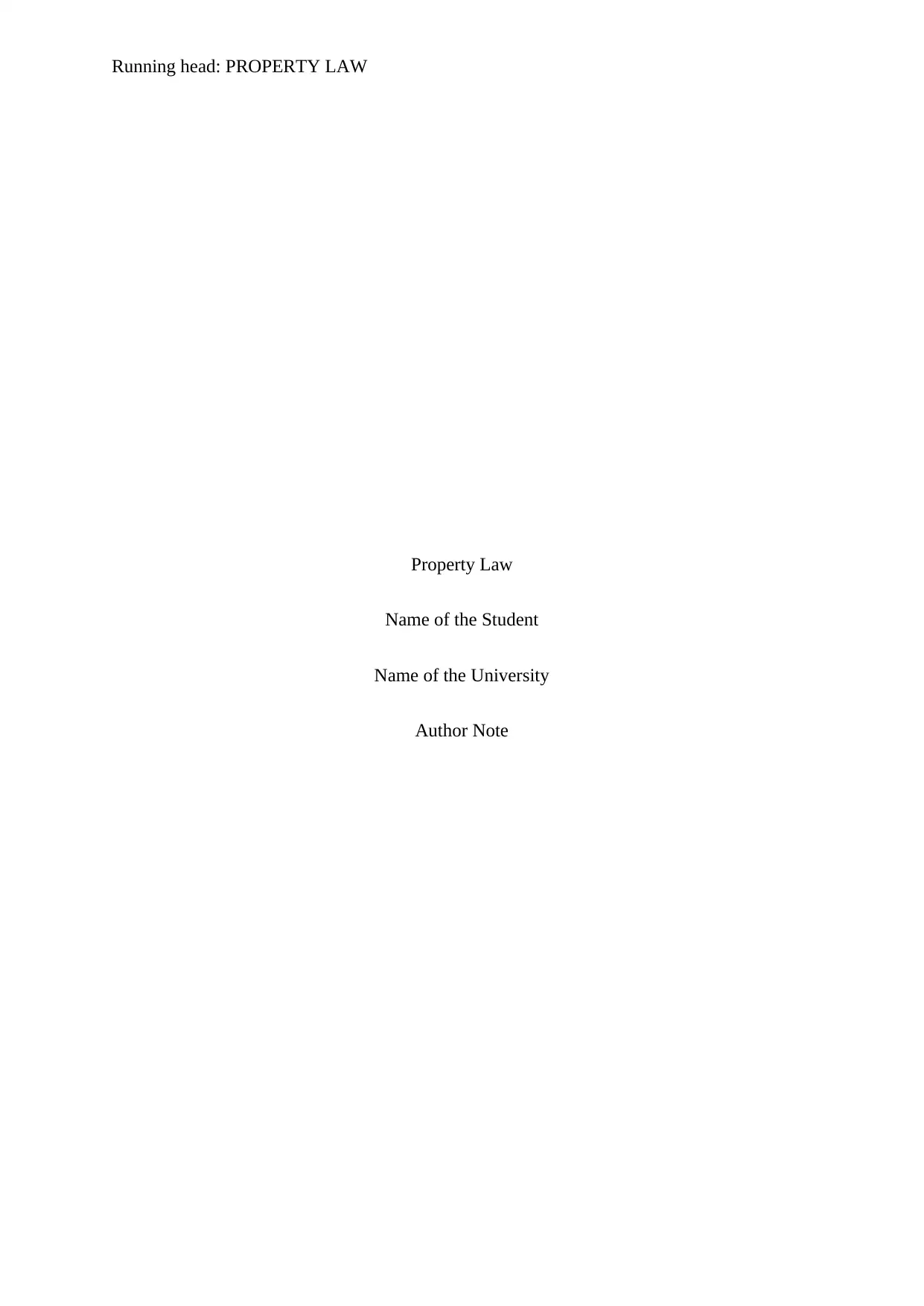
Running head: PROPERTY LAW
Property Law
Name of the Student
Name of the University
Author Note
Property Law
Name of the Student
Name of the University
Author Note
Paraphrase This Document
Need a fresh take? Get an instant paraphrase of this document with our AI Paraphraser
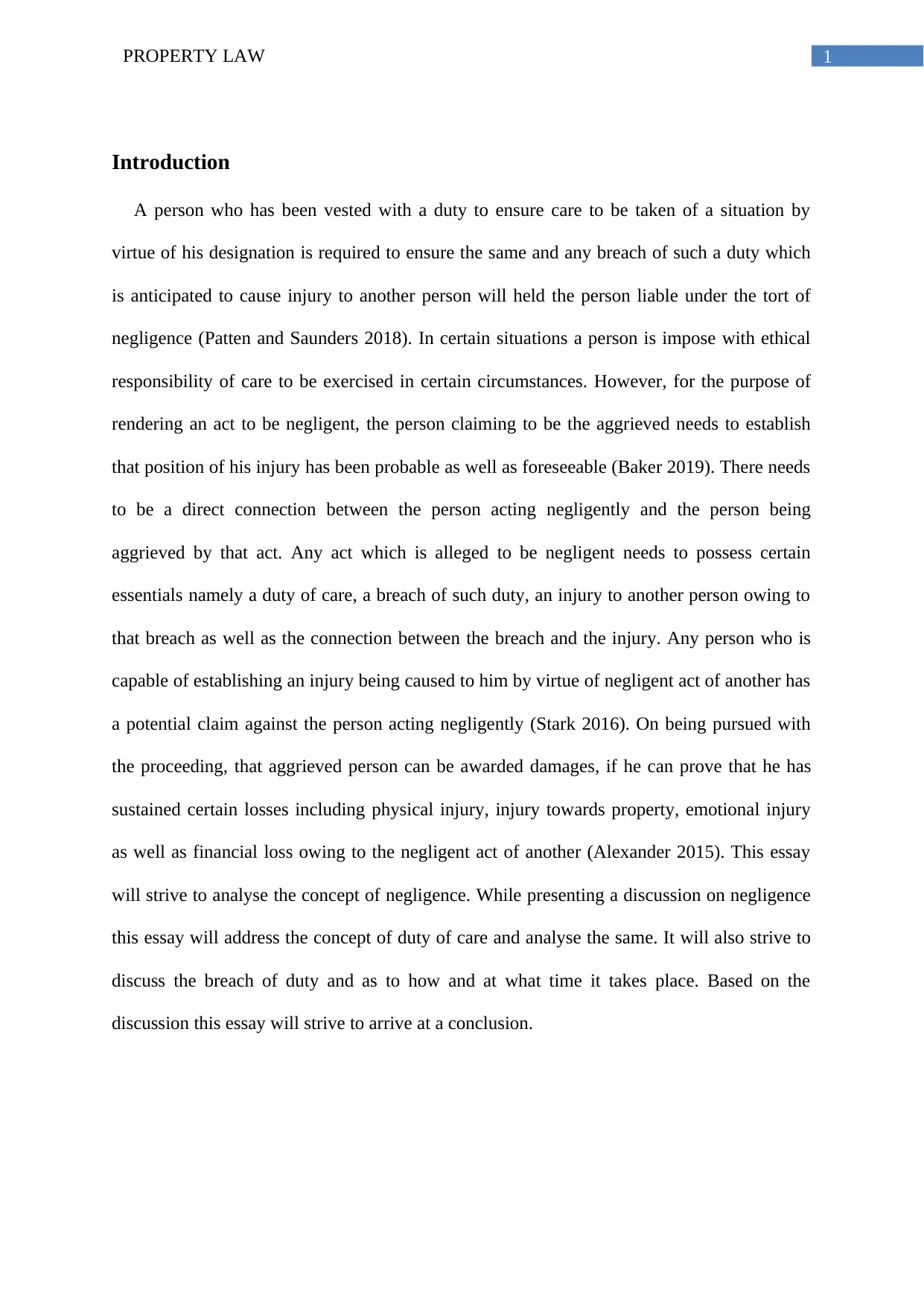
1PROPERTY LAW
Introduction
A person who has been vested with a duty to ensure care to be taken of a situation by
virtue of his designation is required to ensure the same and any breach of such a duty which
is anticipated to cause injury to another person will held the person liable under the tort of
negligence (Patten and Saunders 2018). In certain situations a person is impose with ethical
responsibility of care to be exercised in certain circumstances. However, for the purpose of
rendering an act to be negligent, the person claiming to be the aggrieved needs to establish
that position of his injury has been probable as well as foreseeable (Baker 2019). There needs
to be a direct connection between the person acting negligently and the person being
aggrieved by that act. Any act which is alleged to be negligent needs to possess certain
essentials namely a duty of care, a breach of such duty, an injury to another person owing to
that breach as well as the connection between the breach and the injury. Any person who is
capable of establishing an injury being caused to him by virtue of negligent act of another has
a potential claim against the person acting negligently (Stark 2016). On being pursued with
the proceeding, that aggrieved person can be awarded damages, if he can prove that he has
sustained certain losses including physical injury, injury towards property, emotional injury
as well as financial loss owing to the negligent act of another (Alexander 2015). This essay
will strive to analyse the concept of negligence. While presenting a discussion on negligence
this essay will address the concept of duty of care and analyse the same. It will also strive to
discuss the breach of duty and as to how and at what time it takes place. Based on the
discussion this essay will strive to arrive at a conclusion.
Introduction
A person who has been vested with a duty to ensure care to be taken of a situation by
virtue of his designation is required to ensure the same and any breach of such a duty which
is anticipated to cause injury to another person will held the person liable under the tort of
negligence (Patten and Saunders 2018). In certain situations a person is impose with ethical
responsibility of care to be exercised in certain circumstances. However, for the purpose of
rendering an act to be negligent, the person claiming to be the aggrieved needs to establish
that position of his injury has been probable as well as foreseeable (Baker 2019). There needs
to be a direct connection between the person acting negligently and the person being
aggrieved by that act. Any act which is alleged to be negligent needs to possess certain
essentials namely a duty of care, a breach of such duty, an injury to another person owing to
that breach as well as the connection between the breach and the injury. Any person who is
capable of establishing an injury being caused to him by virtue of negligent act of another has
a potential claim against the person acting negligently (Stark 2016). On being pursued with
the proceeding, that aggrieved person can be awarded damages, if he can prove that he has
sustained certain losses including physical injury, injury towards property, emotional injury
as well as financial loss owing to the negligent act of another (Alexander 2015). This essay
will strive to analyse the concept of negligence. While presenting a discussion on negligence
this essay will address the concept of duty of care and analyse the same. It will also strive to
discuss the breach of duty and as to how and at what time it takes place. Based on the
discussion this essay will strive to arrive at a conclusion.
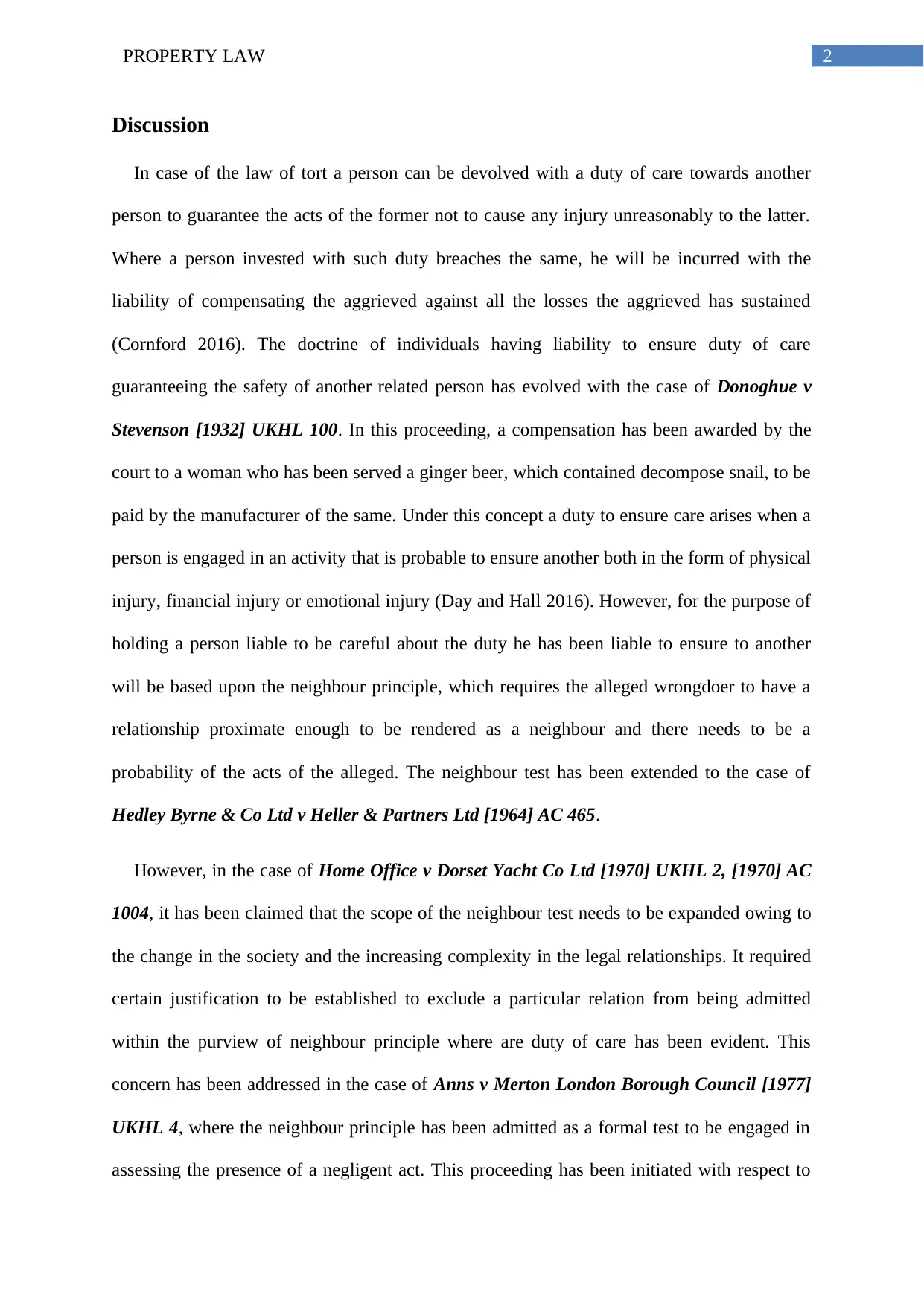
2PROPERTY LAW
Discussion
In case of the law of tort a person can be devolved with a duty of care towards another
person to guarantee the acts of the former not to cause any injury unreasonably to the latter.
Where a person invested with such duty breaches the same, he will be incurred with the
liability of compensating the aggrieved against all the losses the aggrieved has sustained
(Cornford 2016). The doctrine of individuals having liability to ensure duty of care
guaranteeing the safety of another related person has evolved with the case of Donoghue v
Stevenson [1932] UKHL 100. In this proceeding, a compensation has been awarded by the
court to a woman who has been served a ginger beer, which contained decompose snail, to be
paid by the manufacturer of the same. Under this concept a duty to ensure care arises when a
person is engaged in an activity that is probable to ensure another both in the form of physical
injury, financial injury or emotional injury (Day and Hall 2016). However, for the purpose of
holding a person liable to be careful about the duty he has been liable to ensure to another
will be based upon the neighbour principle, which requires the alleged wrongdoer to have a
relationship proximate enough to be rendered as a neighbour and there needs to be a
probability of the acts of the alleged. The neighbour test has been extended to the case of
Hedley Byrne & Co Ltd v Heller & Partners Ltd [1964] AC 465.
However, in the case of Home Office v Dorset Yacht Co Ltd [1970] UKHL 2, [1970] AC
1004, it has been claimed that the scope of the neighbour test needs to be expanded owing to
the change in the society and the increasing complexity in the legal relationships. It required
certain justification to be established to exclude a particular relation from being admitted
within the purview of neighbour principle where are duty of care has been evident. This
concern has been addressed in the case of Anns v Merton London Borough Council [1977]
UKHL 4, where the neighbour principle has been admitted as a formal test to be engaged in
assessing the presence of a negligent act. This proceeding has been initiated with respect to
Discussion
In case of the law of tort a person can be devolved with a duty of care towards another
person to guarantee the acts of the former not to cause any injury unreasonably to the latter.
Where a person invested with such duty breaches the same, he will be incurred with the
liability of compensating the aggrieved against all the losses the aggrieved has sustained
(Cornford 2016). The doctrine of individuals having liability to ensure duty of care
guaranteeing the safety of another related person has evolved with the case of Donoghue v
Stevenson [1932] UKHL 100. In this proceeding, a compensation has been awarded by the
court to a woman who has been served a ginger beer, which contained decompose snail, to be
paid by the manufacturer of the same. Under this concept a duty to ensure care arises when a
person is engaged in an activity that is probable to ensure another both in the form of physical
injury, financial injury or emotional injury (Day and Hall 2016). However, for the purpose of
holding a person liable to be careful about the duty he has been liable to ensure to another
will be based upon the neighbour principle, which requires the alleged wrongdoer to have a
relationship proximate enough to be rendered as a neighbour and there needs to be a
probability of the acts of the alleged. The neighbour test has been extended to the case of
Hedley Byrne & Co Ltd v Heller & Partners Ltd [1964] AC 465.
However, in the case of Home Office v Dorset Yacht Co Ltd [1970] UKHL 2, [1970] AC
1004, it has been claimed that the scope of the neighbour test needs to be expanded owing to
the change in the society and the increasing complexity in the legal relationships. It required
certain justification to be established to exclude a particular relation from being admitted
within the purview of neighbour principle where are duty of care has been evident. This
concern has been addressed in the case of Anns v Merton London Borough Council [1977]
UKHL 4, where the neighbour principle has been admitted as a formal test to be engaged in
assessing the presence of a negligent act. This proceeding has been initiated with respect to
⊘ This is a preview!⊘
Do you want full access?
Subscribe today to unlock all pages.

Trusted by 1+ million students worldwide
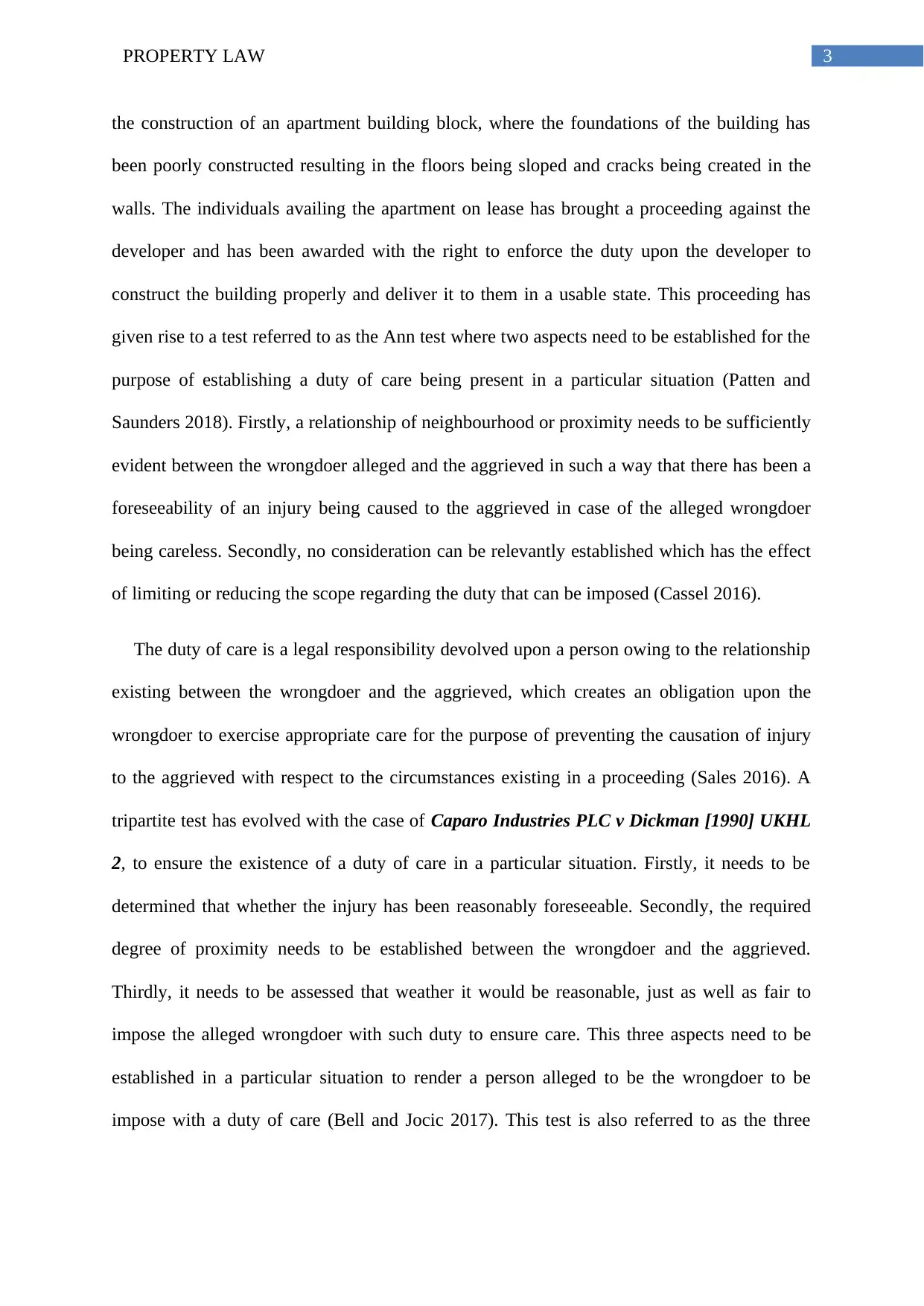
3PROPERTY LAW
the construction of an apartment building block, where the foundations of the building has
been poorly constructed resulting in the floors being sloped and cracks being created in the
walls. The individuals availing the apartment on lease has brought a proceeding against the
developer and has been awarded with the right to enforce the duty upon the developer to
construct the building properly and deliver it to them in a usable state. This proceeding has
given rise to a test referred to as the Ann test where two aspects need to be established for the
purpose of establishing a duty of care being present in a particular situation (Patten and
Saunders 2018). Firstly, a relationship of neighbourhood or proximity needs to be sufficiently
evident between the wrongdoer alleged and the aggrieved in such a way that there has been a
foreseeability of an injury being caused to the aggrieved in case of the alleged wrongdoer
being careless. Secondly, no consideration can be relevantly established which has the effect
of limiting or reducing the scope regarding the duty that can be imposed (Cassel 2016).
The duty of care is a legal responsibility devolved upon a person owing to the relationship
existing between the wrongdoer and the aggrieved, which creates an obligation upon the
wrongdoer to exercise appropriate care for the purpose of preventing the causation of injury
to the aggrieved with respect to the circumstances existing in a proceeding (Sales 2016). A
tripartite test has evolved with the case of Caparo Industries PLC v Dickman [1990] UKHL
2, to ensure the existence of a duty of care in a particular situation. Firstly, it needs to be
determined that whether the injury has been reasonably foreseeable. Secondly, the required
degree of proximity needs to be established between the wrongdoer and the aggrieved.
Thirdly, it needs to be assessed that weather it would be reasonable, just as well as fair to
impose the alleged wrongdoer with such duty to ensure care. This three aspects need to be
established in a particular situation to render a person alleged to be the wrongdoer to be
impose with a duty of care (Bell and Jocic 2017). This test is also referred to as the three
the construction of an apartment building block, where the foundations of the building has
been poorly constructed resulting in the floors being sloped and cracks being created in the
walls. The individuals availing the apartment on lease has brought a proceeding against the
developer and has been awarded with the right to enforce the duty upon the developer to
construct the building properly and deliver it to them in a usable state. This proceeding has
given rise to a test referred to as the Ann test where two aspects need to be established for the
purpose of establishing a duty of care being present in a particular situation (Patten and
Saunders 2018). Firstly, a relationship of neighbourhood or proximity needs to be sufficiently
evident between the wrongdoer alleged and the aggrieved in such a way that there has been a
foreseeability of an injury being caused to the aggrieved in case of the alleged wrongdoer
being careless. Secondly, no consideration can be relevantly established which has the effect
of limiting or reducing the scope regarding the duty that can be imposed (Cassel 2016).
The duty of care is a legal responsibility devolved upon a person owing to the relationship
existing between the wrongdoer and the aggrieved, which creates an obligation upon the
wrongdoer to exercise appropriate care for the purpose of preventing the causation of injury
to the aggrieved with respect to the circumstances existing in a proceeding (Sales 2016). A
tripartite test has evolved with the case of Caparo Industries PLC v Dickman [1990] UKHL
2, to ensure the existence of a duty of care in a particular situation. Firstly, it needs to be
determined that whether the injury has been reasonably foreseeable. Secondly, the required
degree of proximity needs to be established between the wrongdoer and the aggrieved.
Thirdly, it needs to be assessed that weather it would be reasonable, just as well as fair to
impose the alleged wrongdoer with such duty to ensure care. This three aspects need to be
established in a particular situation to render a person alleged to be the wrongdoer to be
impose with a duty of care (Bell and Jocic 2017). This test is also referred to as the three
Paraphrase This Document
Need a fresh take? Get an instant paraphrase of this document with our AI Paraphraser
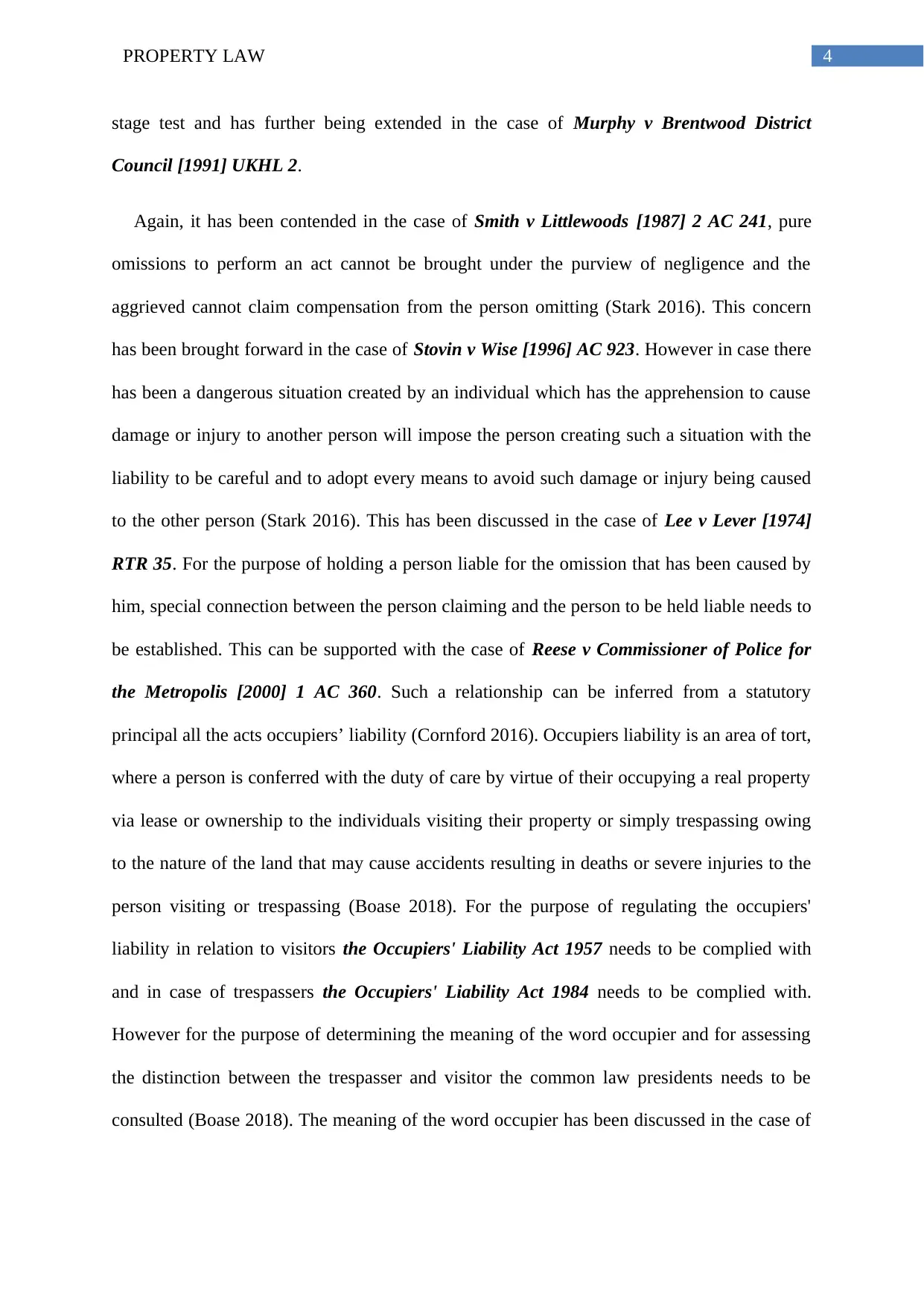
4PROPERTY LAW
stage test and has further being extended in the case of Murphy v Brentwood District
Council [1991] UKHL 2.
Again, it has been contended in the case of Smith v Littlewoods [1987] 2 AC 241, pure
omissions to perform an act cannot be brought under the purview of negligence and the
aggrieved cannot claim compensation from the person omitting (Stark 2016). This concern
has been brought forward in the case of Stovin v Wise [1996] AC 923. However in case there
has been a dangerous situation created by an individual which has the apprehension to cause
damage or injury to another person will impose the person creating such a situation with the
liability to be careful and to adopt every means to avoid such damage or injury being caused
to the other person (Stark 2016). This has been discussed in the case of Lee v Lever [1974]
RTR 35. For the purpose of holding a person liable for the omission that has been caused by
him, special connection between the person claiming and the person to be held liable needs to
be established. This can be supported with the case of Reese v Commissioner of Police for
the Metropolis [2000] 1 AC 360. Such a relationship can be inferred from a statutory
principal all the acts occupiers’ liability (Cornford 2016). Occupiers liability is an area of tort,
where a person is conferred with the duty of care by virtue of their occupying a real property
via lease or ownership to the individuals visiting their property or simply trespassing owing
to the nature of the land that may cause accidents resulting in deaths or severe injuries to the
person visiting or trespassing (Boase 2018). For the purpose of regulating the occupiers'
liability in relation to visitors the Occupiers' Liability Act 1957 needs to be complied with
and in case of trespassers the Occupiers' Liability Act 1984 needs to be complied with.
However for the purpose of determining the meaning of the word occupier and for assessing
the distinction between the trespasser and visitor the common law presidents needs to be
consulted (Boase 2018). The meaning of the word occupier has been discussed in the case of
stage test and has further being extended in the case of Murphy v Brentwood District
Council [1991] UKHL 2.
Again, it has been contended in the case of Smith v Littlewoods [1987] 2 AC 241, pure
omissions to perform an act cannot be brought under the purview of negligence and the
aggrieved cannot claim compensation from the person omitting (Stark 2016). This concern
has been brought forward in the case of Stovin v Wise [1996] AC 923. However in case there
has been a dangerous situation created by an individual which has the apprehension to cause
damage or injury to another person will impose the person creating such a situation with the
liability to be careful and to adopt every means to avoid such damage or injury being caused
to the other person (Stark 2016). This has been discussed in the case of Lee v Lever [1974]
RTR 35. For the purpose of holding a person liable for the omission that has been caused by
him, special connection between the person claiming and the person to be held liable needs to
be established. This can be supported with the case of Reese v Commissioner of Police for
the Metropolis [2000] 1 AC 360. Such a relationship can be inferred from a statutory
principal all the acts occupiers’ liability (Cornford 2016). Occupiers liability is an area of tort,
where a person is conferred with the duty of care by virtue of their occupying a real property
via lease or ownership to the individuals visiting their property or simply trespassing owing
to the nature of the land that may cause accidents resulting in deaths or severe injuries to the
person visiting or trespassing (Boase 2018). For the purpose of regulating the occupiers'
liability in relation to visitors the Occupiers' Liability Act 1957 needs to be complied with
and in case of trespassers the Occupiers' Liability Act 1984 needs to be complied with.
However for the purpose of determining the meaning of the word occupier and for assessing
the distinction between the trespasser and visitor the common law presidents needs to be
consulted (Boase 2018). The meaning of the word occupier has been discussed in the case of
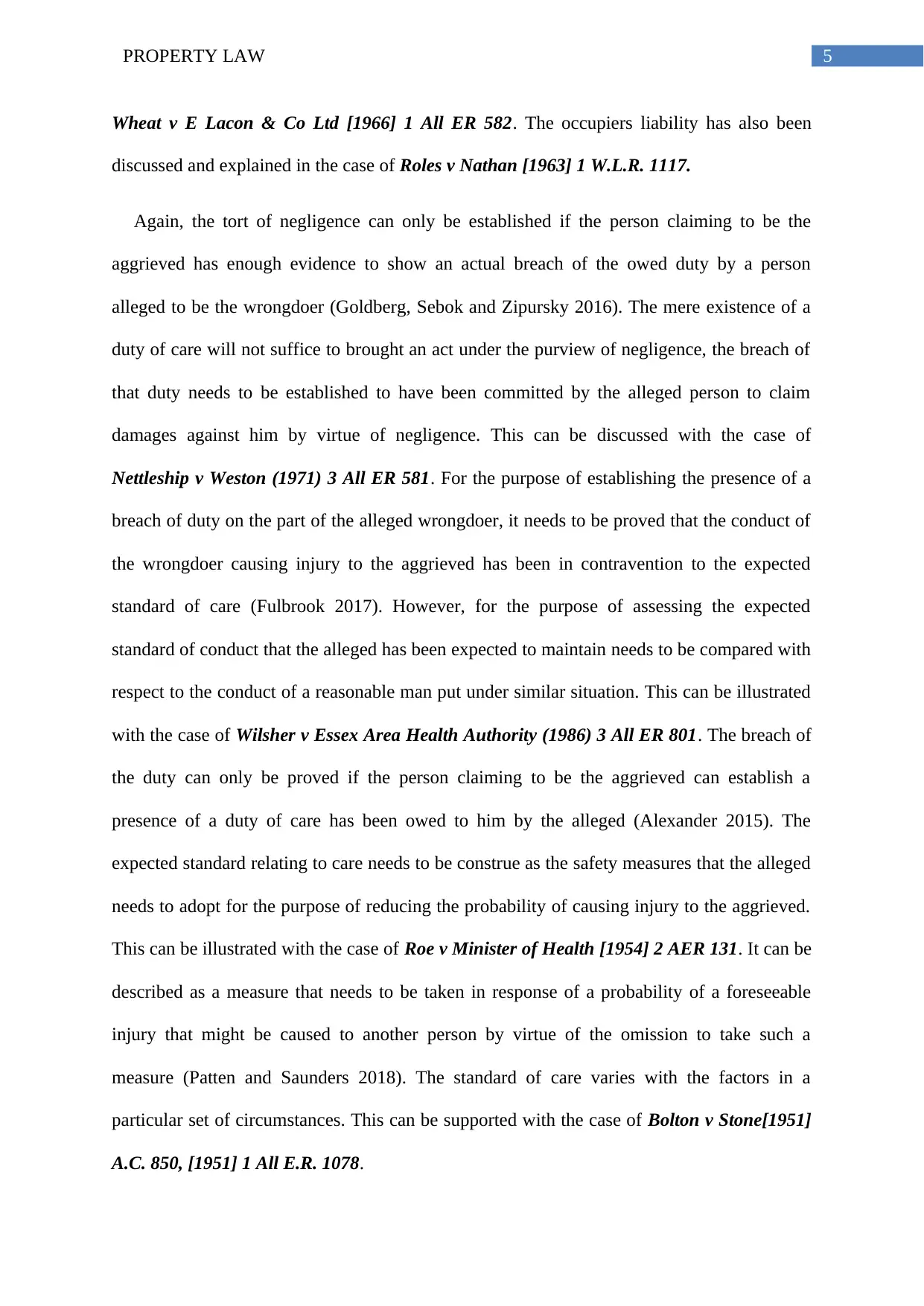
5PROPERTY LAW
Wheat v E Lacon & Co Ltd [1966] 1 All ER 582. The occupiers liability has also been
discussed and explained in the case of Roles v Nathan [1963] 1 W.L.R. 1117.
Again, the tort of negligence can only be established if the person claiming to be the
aggrieved has enough evidence to show an actual breach of the owed duty by a person
alleged to be the wrongdoer (Goldberg, Sebok and Zipursky 2016). The mere existence of a
duty of care will not suffice to brought an act under the purview of negligence, the breach of
that duty needs to be established to have been committed by the alleged person to claim
damages against him by virtue of negligence. This can be discussed with the case of
Nettleship v Weston (1971) 3 All ER 581. For the purpose of establishing the presence of a
breach of duty on the part of the alleged wrongdoer, it needs to be proved that the conduct of
the wrongdoer causing injury to the aggrieved has been in contravention to the expected
standard of care (Fulbrook 2017). However, for the purpose of assessing the expected
standard of conduct that the alleged has been expected to maintain needs to be compared with
respect to the conduct of a reasonable man put under similar situation. This can be illustrated
with the case of Wilsher v Essex Area Health Authority (1986) 3 All ER 801. The breach of
the duty can only be proved if the person claiming to be the aggrieved can establish a
presence of a duty of care has been owed to him by the alleged (Alexander 2015). The
expected standard relating to care needs to be construe as the safety measures that the alleged
needs to adopt for the purpose of reducing the probability of causing injury to the aggrieved.
This can be illustrated with the case of Roe v Minister of Health [1954] 2 AER 131. It can be
described as a measure that needs to be taken in response of a probability of a foreseeable
injury that might be caused to another person by virtue of the omission to take such a
measure (Patten and Saunders 2018). The standard of care varies with the factors in a
particular set of circumstances. This can be supported with the case of Bolton v Stone[1951]
A.C. 850, [1951] 1 All E.R. 1078.
Wheat v E Lacon & Co Ltd [1966] 1 All ER 582. The occupiers liability has also been
discussed and explained in the case of Roles v Nathan [1963] 1 W.L.R. 1117.
Again, the tort of negligence can only be established if the person claiming to be the
aggrieved has enough evidence to show an actual breach of the owed duty by a person
alleged to be the wrongdoer (Goldberg, Sebok and Zipursky 2016). The mere existence of a
duty of care will not suffice to brought an act under the purview of negligence, the breach of
that duty needs to be established to have been committed by the alleged person to claim
damages against him by virtue of negligence. This can be discussed with the case of
Nettleship v Weston (1971) 3 All ER 581. For the purpose of establishing the presence of a
breach of duty on the part of the alleged wrongdoer, it needs to be proved that the conduct of
the wrongdoer causing injury to the aggrieved has been in contravention to the expected
standard of care (Fulbrook 2017). However, for the purpose of assessing the expected
standard of conduct that the alleged has been expected to maintain needs to be compared with
respect to the conduct of a reasonable man put under similar situation. This can be illustrated
with the case of Wilsher v Essex Area Health Authority (1986) 3 All ER 801. The breach of
the duty can only be proved if the person claiming to be the aggrieved can establish a
presence of a duty of care has been owed to him by the alleged (Alexander 2015). The
expected standard relating to care needs to be construe as the safety measures that the alleged
needs to adopt for the purpose of reducing the probability of causing injury to the aggrieved.
This can be illustrated with the case of Roe v Minister of Health [1954] 2 AER 131. It can be
described as a measure that needs to be taken in response of a probability of a foreseeable
injury that might be caused to another person by virtue of the omission to take such a
measure (Patten and Saunders 2018). The standard of care varies with the factors in a
particular set of circumstances. This can be supported with the case of Bolton v Stone[1951]
A.C. 850, [1951] 1 All E.R. 1078.
⊘ This is a preview!⊘
Do you want full access?
Subscribe today to unlock all pages.

Trusted by 1+ million students worldwide
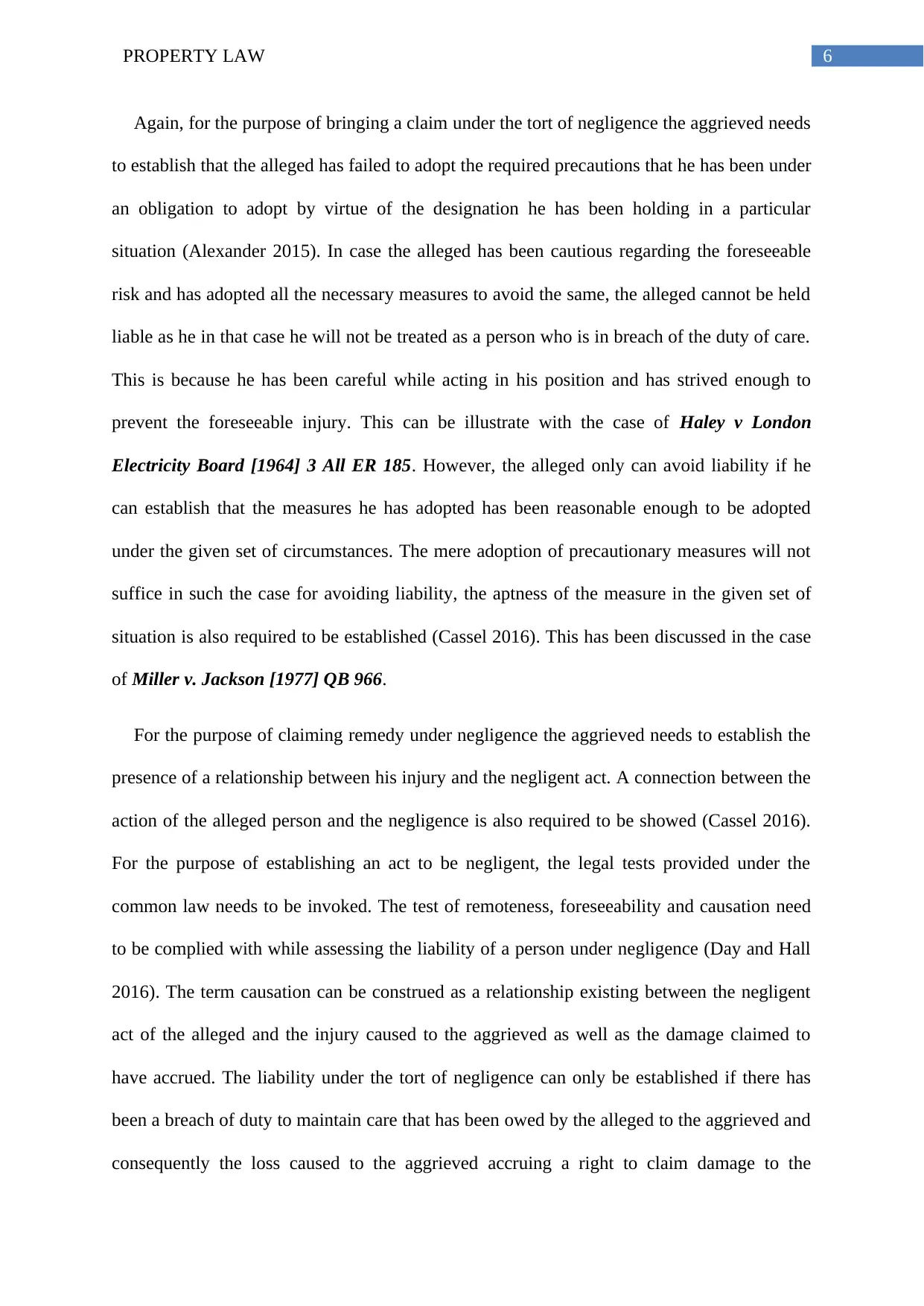
6PROPERTY LAW
Again, for the purpose of bringing a claim under the tort of negligence the aggrieved needs
to establish that the alleged has failed to adopt the required precautions that he has been under
an obligation to adopt by virtue of the designation he has been holding in a particular
situation (Alexander 2015). In case the alleged has been cautious regarding the foreseeable
risk and has adopted all the necessary measures to avoid the same, the alleged cannot be held
liable as he in that case he will not be treated as a person who is in breach of the duty of care.
This is because he has been careful while acting in his position and has strived enough to
prevent the foreseeable injury. This can be illustrate with the case of Haley v London
Electricity Board [1964] 3 All ER 185. However, the alleged only can avoid liability if he
can establish that the measures he has adopted has been reasonable enough to be adopted
under the given set of circumstances. The mere adoption of precautionary measures will not
suffice in such the case for avoiding liability, the aptness of the measure in the given set of
situation is also required to be established (Cassel 2016). This has been discussed in the case
of Miller v. Jackson [1977] QB 966.
For the purpose of claiming remedy under negligence the aggrieved needs to establish the
presence of a relationship between his injury and the negligent act. A connection between the
action of the alleged person and the negligence is also required to be showed (Cassel 2016).
For the purpose of establishing an act to be negligent, the legal tests provided under the
common law needs to be invoked. The test of remoteness, foreseeability and causation need
to be complied with while assessing the liability of a person under negligence (Day and Hall
2016). The term causation can be construed as a relationship existing between the negligent
act of the alleged and the injury caused to the aggrieved as well as the damage claimed to
have accrued. The liability under the tort of negligence can only be established if there has
been a breach of duty to maintain care that has been owed by the alleged to the aggrieved and
consequently the loss caused to the aggrieved accruing a right to claim damage to the
Again, for the purpose of bringing a claim under the tort of negligence the aggrieved needs
to establish that the alleged has failed to adopt the required precautions that he has been under
an obligation to adopt by virtue of the designation he has been holding in a particular
situation (Alexander 2015). In case the alleged has been cautious regarding the foreseeable
risk and has adopted all the necessary measures to avoid the same, the alleged cannot be held
liable as he in that case he will not be treated as a person who is in breach of the duty of care.
This is because he has been careful while acting in his position and has strived enough to
prevent the foreseeable injury. This can be illustrate with the case of Haley v London
Electricity Board [1964] 3 All ER 185. However, the alleged only can avoid liability if he
can establish that the measures he has adopted has been reasonable enough to be adopted
under the given set of circumstances. The mere adoption of precautionary measures will not
suffice in such the case for avoiding liability, the aptness of the measure in the given set of
situation is also required to be established (Cassel 2016). This has been discussed in the case
of Miller v. Jackson [1977] QB 966.
For the purpose of claiming remedy under negligence the aggrieved needs to establish the
presence of a relationship between his injury and the negligent act. A connection between the
action of the alleged person and the negligence is also required to be showed (Cassel 2016).
For the purpose of establishing an act to be negligent, the legal tests provided under the
common law needs to be invoked. The test of remoteness, foreseeability and causation need
to be complied with while assessing the liability of a person under negligence (Day and Hall
2016). The term causation can be construed as a relationship existing between the negligent
act of the alleged and the injury caused to the aggrieved as well as the damage claimed to
have accrued. The liability under the tort of negligence can only be established if there has
been a breach of duty to maintain care that has been owed by the alleged to the aggrieved and
consequently the loss caused to the aggrieved accruing a right to claim damage to the
Paraphrase This Document
Need a fresh take? Get an instant paraphrase of this document with our AI Paraphraser
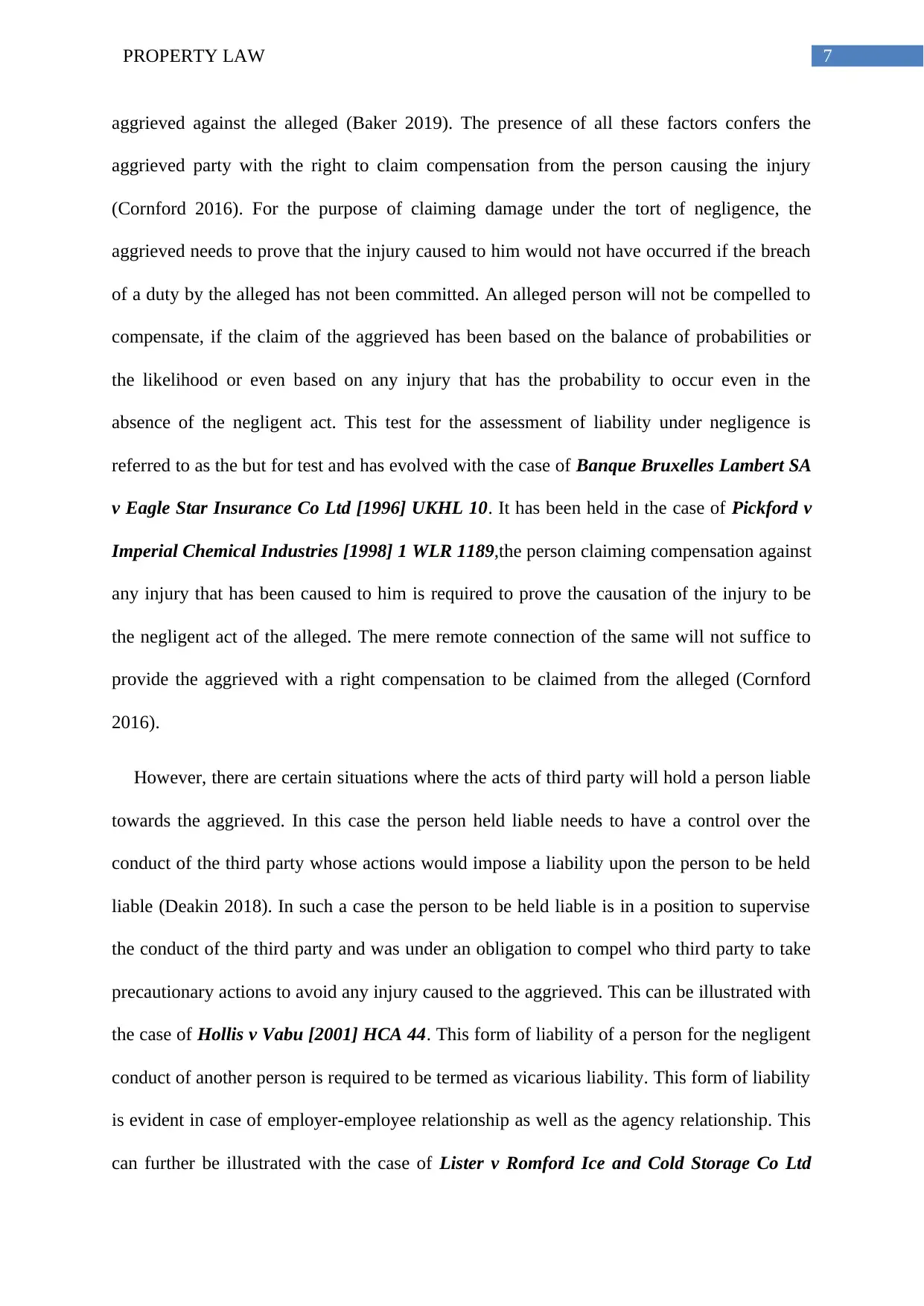
7PROPERTY LAW
aggrieved against the alleged (Baker 2019). The presence of all these factors confers the
aggrieved party with the right to claim compensation from the person causing the injury
(Cornford 2016). For the purpose of claiming damage under the tort of negligence, the
aggrieved needs to prove that the injury caused to him would not have occurred if the breach
of a duty by the alleged has not been committed. An alleged person will not be compelled to
compensate, if the claim of the aggrieved has been based on the balance of probabilities or
the likelihood or even based on any injury that has the probability to occur even in the
absence of the negligent act. This test for the assessment of liability under negligence is
referred to as the but for test and has evolved with the case of Banque Bruxelles Lambert SA
v Eagle Star Insurance Co Ltd [1996] UKHL 10. It has been held in the case of Pickford v
Imperial Chemical Industries [1998] 1 WLR 1189,the person claiming compensation against
any injury that has been caused to him is required to prove the causation of the injury to be
the negligent act of the alleged. The mere remote connection of the same will not suffice to
provide the aggrieved with a right compensation to be claimed from the alleged (Cornford
2016).
However, there are certain situations where the acts of third party will hold a person liable
towards the aggrieved. In this case the person held liable needs to have a control over the
conduct of the third party whose actions would impose a liability upon the person to be held
liable (Deakin 2018). In such a case the person to be held liable is in a position to supervise
the conduct of the third party and was under an obligation to compel who third party to take
precautionary actions to avoid any injury caused to the aggrieved. This can be illustrated with
the case of Hollis v Vabu [2001] HCA 44. This form of liability of a person for the negligent
conduct of another person is required to be termed as vicarious liability. This form of liability
is evident in case of employer-employee relationship as well as the agency relationship. This
can further be illustrated with the case of Lister v Romford Ice and Cold Storage Co Ltd
aggrieved against the alleged (Baker 2019). The presence of all these factors confers the
aggrieved party with the right to claim compensation from the person causing the injury
(Cornford 2016). For the purpose of claiming damage under the tort of negligence, the
aggrieved needs to prove that the injury caused to him would not have occurred if the breach
of a duty by the alleged has not been committed. An alleged person will not be compelled to
compensate, if the claim of the aggrieved has been based on the balance of probabilities or
the likelihood or even based on any injury that has the probability to occur even in the
absence of the negligent act. This test for the assessment of liability under negligence is
referred to as the but for test and has evolved with the case of Banque Bruxelles Lambert SA
v Eagle Star Insurance Co Ltd [1996] UKHL 10. It has been held in the case of Pickford v
Imperial Chemical Industries [1998] 1 WLR 1189,the person claiming compensation against
any injury that has been caused to him is required to prove the causation of the injury to be
the negligent act of the alleged. The mere remote connection of the same will not suffice to
provide the aggrieved with a right compensation to be claimed from the alleged (Cornford
2016).
However, there are certain situations where the acts of third party will hold a person liable
towards the aggrieved. In this case the person held liable needs to have a control over the
conduct of the third party whose actions would impose a liability upon the person to be held
liable (Deakin 2018). In such a case the person to be held liable is in a position to supervise
the conduct of the third party and was under an obligation to compel who third party to take
precautionary actions to avoid any injury caused to the aggrieved. This can be illustrated with
the case of Hollis v Vabu [2001] HCA 44. This form of liability of a person for the negligent
conduct of another person is required to be termed as vicarious liability. This form of liability
is evident in case of employer-employee relationship as well as the agency relationship. This
can further be illustrated with the case of Lister v Romford Ice and Cold Storage Co Ltd
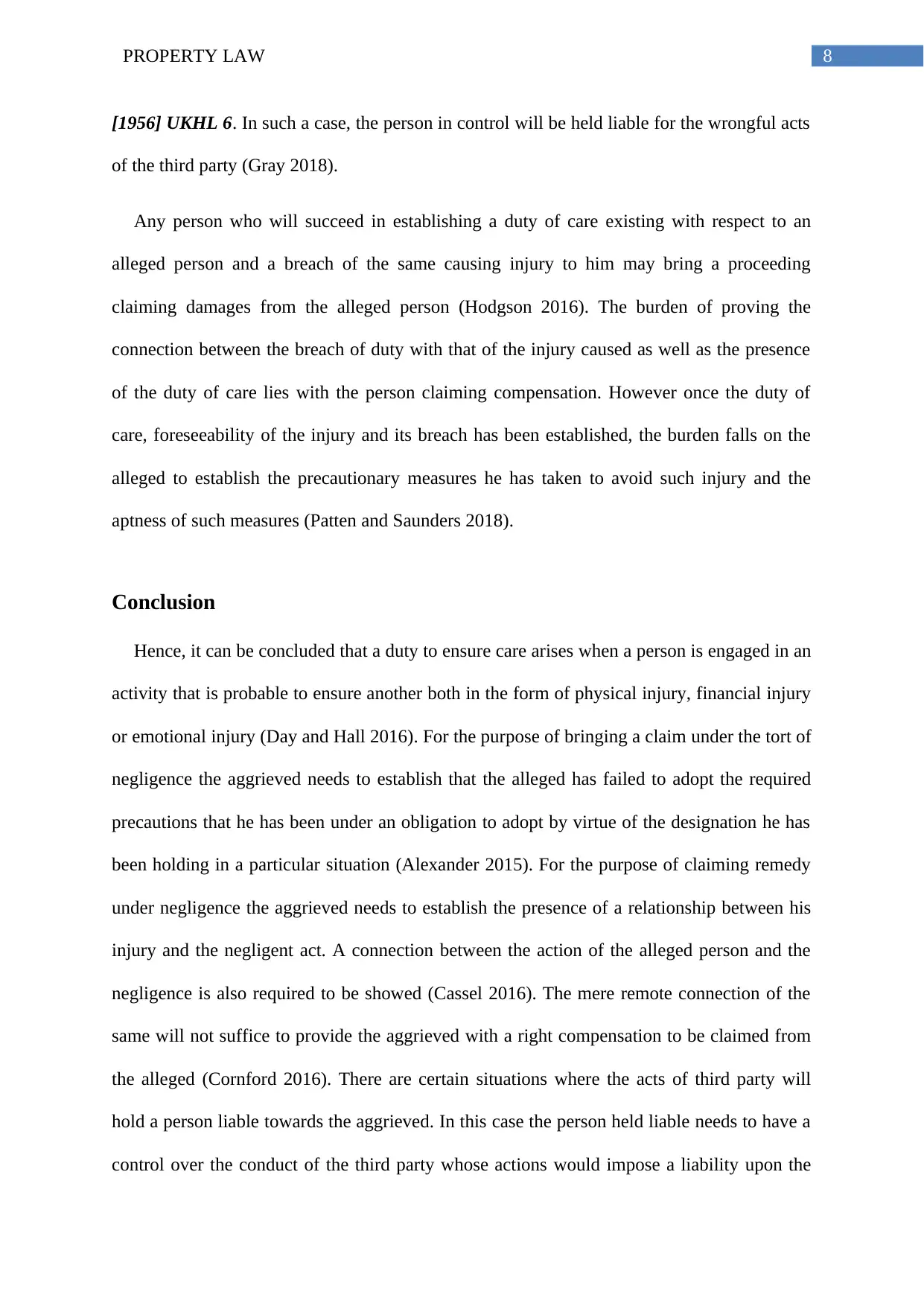
8PROPERTY LAW
[1956] UKHL 6. In such a case, the person in control will be held liable for the wrongful acts
of the third party (Gray 2018).
Any person who will succeed in establishing a duty of care existing with respect to an
alleged person and a breach of the same causing injury to him may bring a proceeding
claiming damages from the alleged person (Hodgson 2016). The burden of proving the
connection between the breach of duty with that of the injury caused as well as the presence
of the duty of care lies with the person claiming compensation. However once the duty of
care, foreseeability of the injury and its breach has been established, the burden falls on the
alleged to establish the precautionary measures he has taken to avoid such injury and the
aptness of such measures (Patten and Saunders 2018).
Conclusion
Hence, it can be concluded that a duty to ensure care arises when a person is engaged in an
activity that is probable to ensure another both in the form of physical injury, financial injury
or emotional injury (Day and Hall 2016). For the purpose of bringing a claim under the tort of
negligence the aggrieved needs to establish that the alleged has failed to adopt the required
precautions that he has been under an obligation to adopt by virtue of the designation he has
been holding in a particular situation (Alexander 2015). For the purpose of claiming remedy
under negligence the aggrieved needs to establish the presence of a relationship between his
injury and the negligent act. A connection between the action of the alleged person and the
negligence is also required to be showed (Cassel 2016). The mere remote connection of the
same will not suffice to provide the aggrieved with a right compensation to be claimed from
the alleged (Cornford 2016). There are certain situations where the acts of third party will
hold a person liable towards the aggrieved. In this case the person held liable needs to have a
control over the conduct of the third party whose actions would impose a liability upon the
[1956] UKHL 6. In such a case, the person in control will be held liable for the wrongful acts
of the third party (Gray 2018).
Any person who will succeed in establishing a duty of care existing with respect to an
alleged person and a breach of the same causing injury to him may bring a proceeding
claiming damages from the alleged person (Hodgson 2016). The burden of proving the
connection between the breach of duty with that of the injury caused as well as the presence
of the duty of care lies with the person claiming compensation. However once the duty of
care, foreseeability of the injury and its breach has been established, the burden falls on the
alleged to establish the precautionary measures he has taken to avoid such injury and the
aptness of such measures (Patten and Saunders 2018).
Conclusion
Hence, it can be concluded that a duty to ensure care arises when a person is engaged in an
activity that is probable to ensure another both in the form of physical injury, financial injury
or emotional injury (Day and Hall 2016). For the purpose of bringing a claim under the tort of
negligence the aggrieved needs to establish that the alleged has failed to adopt the required
precautions that he has been under an obligation to adopt by virtue of the designation he has
been holding in a particular situation (Alexander 2015). For the purpose of claiming remedy
under negligence the aggrieved needs to establish the presence of a relationship between his
injury and the negligent act. A connection between the action of the alleged person and the
negligence is also required to be showed (Cassel 2016). The mere remote connection of the
same will not suffice to provide the aggrieved with a right compensation to be claimed from
the alleged (Cornford 2016). There are certain situations where the acts of third party will
hold a person liable towards the aggrieved. In this case the person held liable needs to have a
control over the conduct of the third party whose actions would impose a liability upon the
⊘ This is a preview!⊘
Do you want full access?
Subscribe today to unlock all pages.

Trusted by 1+ million students worldwide
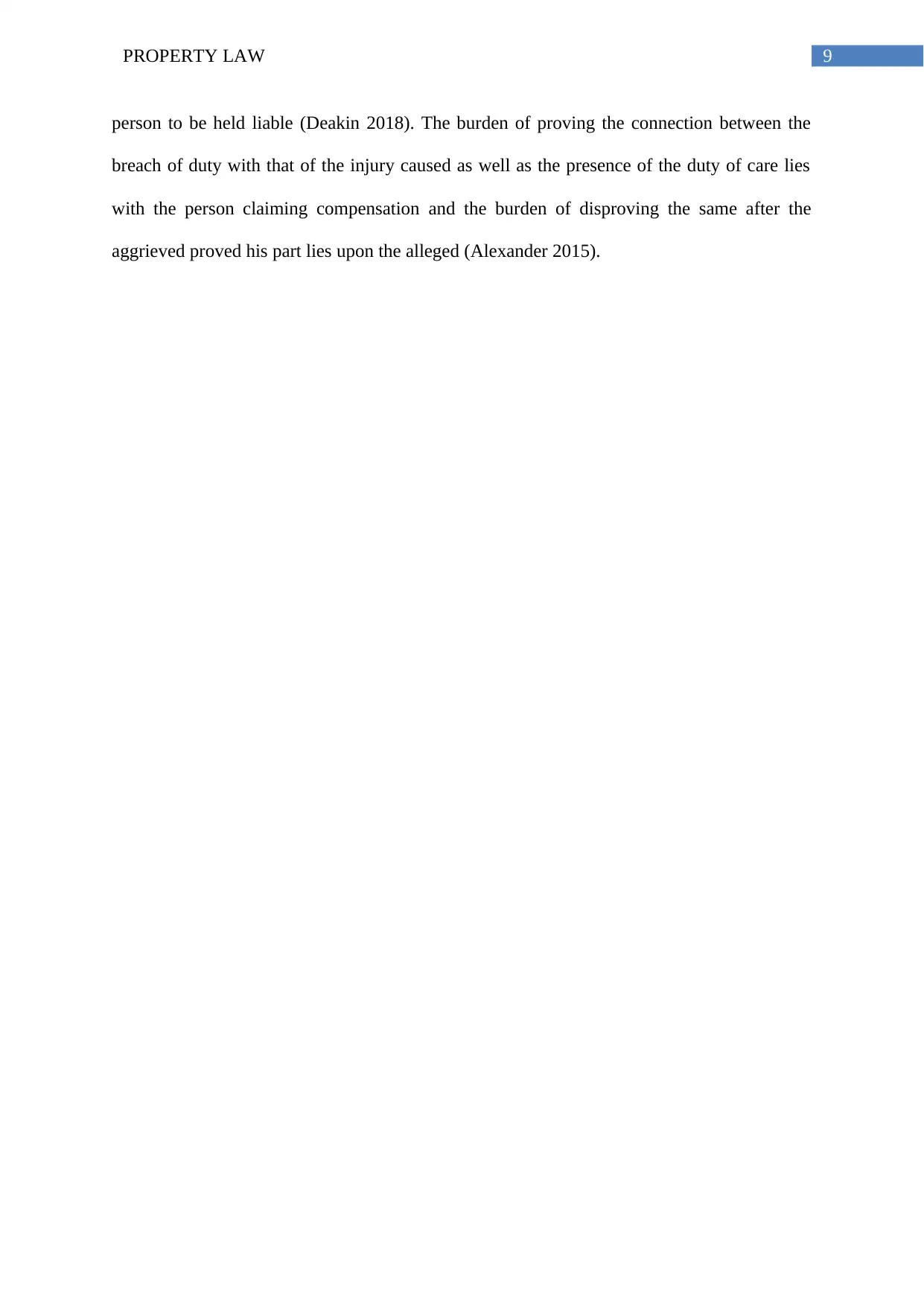
9PROPERTY LAW
person to be held liable (Deakin 2018). The burden of proving the connection between the
breach of duty with that of the injury caused as well as the presence of the duty of care lies
with the person claiming compensation and the burden of disproving the same after the
aggrieved proved his part lies upon the alleged (Alexander 2015).
person to be held liable (Deakin 2018). The burden of proving the connection between the
breach of duty with that of the injury caused as well as the presence of the duty of care lies
with the person claiming compensation and the burden of disproving the same after the
aggrieved proved his part lies upon the alleged (Alexander 2015).
Paraphrase This Document
Need a fresh take? Get an instant paraphrase of this document with our AI Paraphraser
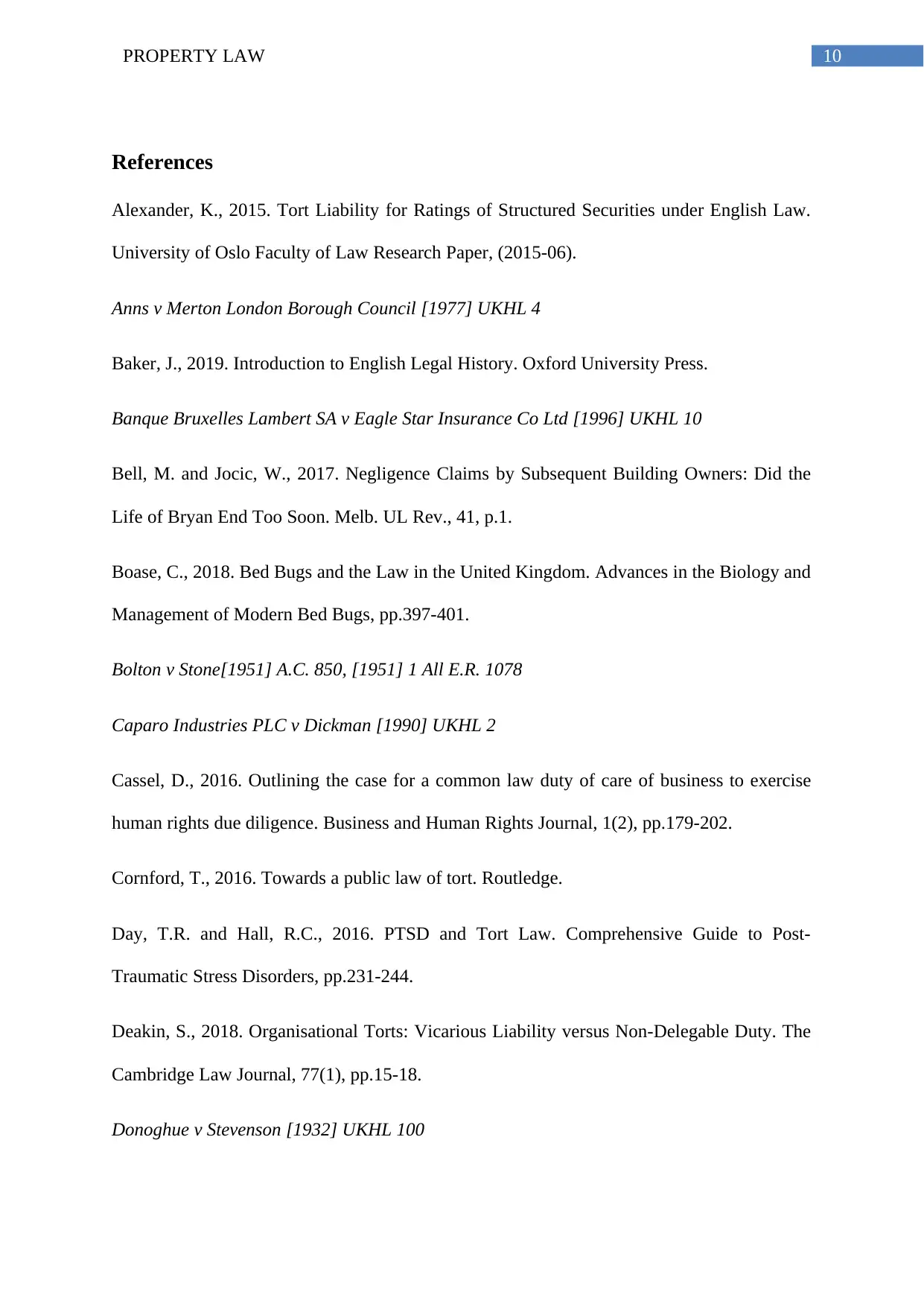
10PROPERTY LAW
References
Alexander, K., 2015. Tort Liability for Ratings of Structured Securities under English Law.
University of Oslo Faculty of Law Research Paper, (2015-06).
Anns v Merton London Borough Council [1977] UKHL 4
Baker, J., 2019. Introduction to English Legal History. Oxford University Press.
Banque Bruxelles Lambert SA v Eagle Star Insurance Co Ltd [1996] UKHL 10
Bell, M. and Jocic, W., 2017. Negligence Claims by Subsequent Building Owners: Did the
Life of Bryan End Too Soon. Melb. UL Rev., 41, p.1.
Boase, C., 2018. Bed Bugs and the Law in the United Kingdom. Advances in the Biology and
Management of Modern Bed Bugs, pp.397-401.
Bolton v Stone[1951] A.C. 850, [1951] 1 All E.R. 1078
Caparo Industries PLC v Dickman [1990] UKHL 2
Cassel, D., 2016. Outlining the case for a common law duty of care of business to exercise
human rights due diligence. Business and Human Rights Journal, 1(2), pp.179-202.
Cornford, T., 2016. Towards a public law of tort. Routledge.
Day, T.R. and Hall, R.C., 2016. PTSD and Tort Law. Comprehensive Guide to Post-
Traumatic Stress Disorders, pp.231-244.
Deakin, S., 2018. Organisational Torts: Vicarious Liability versus Non-Delegable Duty. The
Cambridge Law Journal, 77(1), pp.15-18.
Donoghue v Stevenson [1932] UKHL 100
References
Alexander, K., 2015. Tort Liability for Ratings of Structured Securities under English Law.
University of Oslo Faculty of Law Research Paper, (2015-06).
Anns v Merton London Borough Council [1977] UKHL 4
Baker, J., 2019. Introduction to English Legal History. Oxford University Press.
Banque Bruxelles Lambert SA v Eagle Star Insurance Co Ltd [1996] UKHL 10
Bell, M. and Jocic, W., 2017. Negligence Claims by Subsequent Building Owners: Did the
Life of Bryan End Too Soon. Melb. UL Rev., 41, p.1.
Boase, C., 2018. Bed Bugs and the Law in the United Kingdom. Advances in the Biology and
Management of Modern Bed Bugs, pp.397-401.
Bolton v Stone[1951] A.C. 850, [1951] 1 All E.R. 1078
Caparo Industries PLC v Dickman [1990] UKHL 2
Cassel, D., 2016. Outlining the case for a common law duty of care of business to exercise
human rights due diligence. Business and Human Rights Journal, 1(2), pp.179-202.
Cornford, T., 2016. Towards a public law of tort. Routledge.
Day, T.R. and Hall, R.C., 2016. PTSD and Tort Law. Comprehensive Guide to Post-
Traumatic Stress Disorders, pp.231-244.
Deakin, S., 2018. Organisational Torts: Vicarious Liability versus Non-Delegable Duty. The
Cambridge Law Journal, 77(1), pp.15-18.
Donoghue v Stevenson [1932] UKHL 100
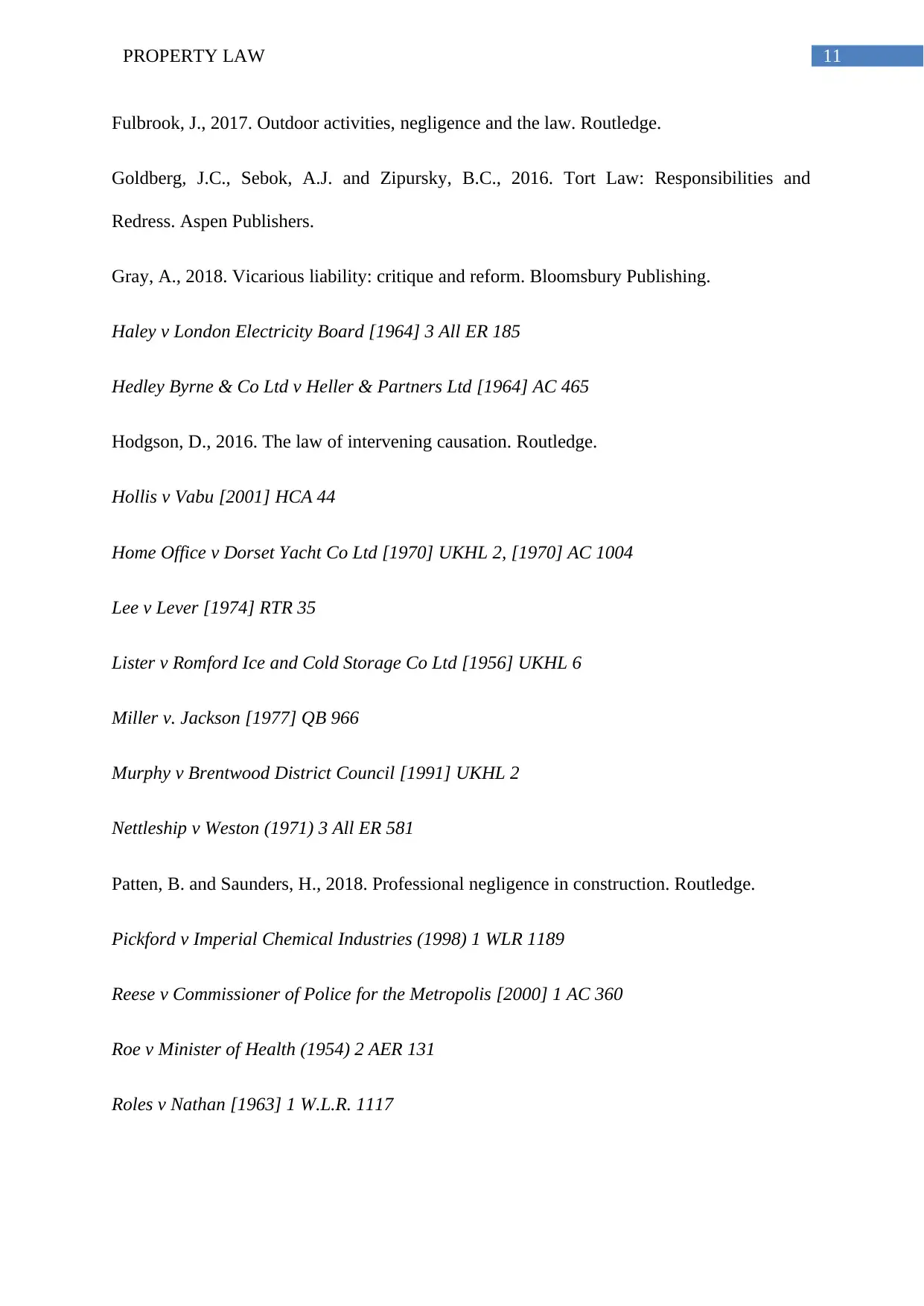
11PROPERTY LAW
Fulbrook, J., 2017. Outdoor activities, negligence and the law. Routledge.
Goldberg, J.C., Sebok, A.J. and Zipursky, B.C., 2016. Tort Law: Responsibilities and
Redress. Aspen Publishers.
Gray, A., 2018. Vicarious liability: critique and reform. Bloomsbury Publishing.
Haley v London Electricity Board [1964] 3 All ER 185
Hedley Byrne & Co Ltd v Heller & Partners Ltd [1964] AC 465
Hodgson, D., 2016. The law of intervening causation. Routledge.
Hollis v Vabu [2001] HCA 44
Home Office v Dorset Yacht Co Ltd [1970] UKHL 2, [1970] AC 1004
Lee v Lever [1974] RTR 35
Lister v Romford Ice and Cold Storage Co Ltd [1956] UKHL 6
Miller v. Jackson [1977] QB 966
Murphy v Brentwood District Council [1991] UKHL 2
Nettleship v Weston (1971) 3 All ER 581
Patten, B. and Saunders, H., 2018. Professional negligence in construction. Routledge.
Pickford v Imperial Chemical Industries (1998) 1 WLR 1189
Reese v Commissioner of Police for the Metropolis [2000] 1 AC 360
Roe v Minister of Health (1954) 2 AER 131
Roles v Nathan [1963] 1 W.L.R. 1117
Fulbrook, J., 2017. Outdoor activities, negligence and the law. Routledge.
Goldberg, J.C., Sebok, A.J. and Zipursky, B.C., 2016. Tort Law: Responsibilities and
Redress. Aspen Publishers.
Gray, A., 2018. Vicarious liability: critique and reform. Bloomsbury Publishing.
Haley v London Electricity Board [1964] 3 All ER 185
Hedley Byrne & Co Ltd v Heller & Partners Ltd [1964] AC 465
Hodgson, D., 2016. The law of intervening causation. Routledge.
Hollis v Vabu [2001] HCA 44
Home Office v Dorset Yacht Co Ltd [1970] UKHL 2, [1970] AC 1004
Lee v Lever [1974] RTR 35
Lister v Romford Ice and Cold Storage Co Ltd [1956] UKHL 6
Miller v. Jackson [1977] QB 966
Murphy v Brentwood District Council [1991] UKHL 2
Nettleship v Weston (1971) 3 All ER 581
Patten, B. and Saunders, H., 2018. Professional negligence in construction. Routledge.
Pickford v Imperial Chemical Industries (1998) 1 WLR 1189
Reese v Commissioner of Police for the Metropolis [2000] 1 AC 360
Roe v Minister of Health (1954) 2 AER 131
Roles v Nathan [1963] 1 W.L.R. 1117
⊘ This is a preview!⊘
Do you want full access?
Subscribe today to unlock all pages.

Trusted by 1+ million students worldwide
1 out of 13
Related Documents
Your All-in-One AI-Powered Toolkit for Academic Success.
+13062052269
info@desklib.com
Available 24*7 on WhatsApp / Email
![[object Object]](/_next/static/media/star-bottom.7253800d.svg)
Unlock your academic potential
Copyright © 2020–2025 A2Z Services. All Rights Reserved. Developed and managed by ZUCOL.





